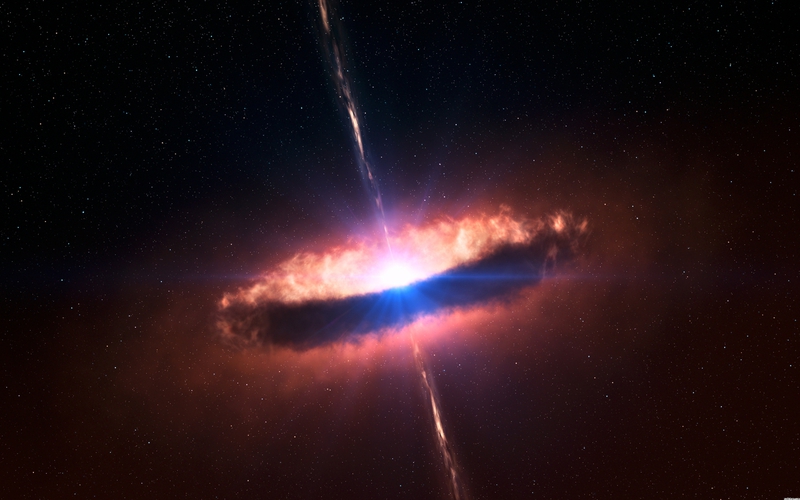"If CO2 came from volcanoes from our past and oxygen came from photosynthesis, where did nitrogen come from?" - Anon
A question that almost every parent gets sometime in their life: "Mommy? Where did we come from?" While the answer is relatively clear and scientifically identifiable, we always run with the old fallback answer, "a stork delivered you in the night." In reality, all of the mass in all of the universe was created during the big bang and then changed and transformed in the following 13.7 billion years. Stars took the primitive hydrogen atoms and fused them together to make helium, which fused to create nitogen, which fused to make carbon, which fused to make neon, and so on and so forth. All atoms in the universe were made in this fashion. But when the star could no longer handle the unreasonable workload, it gave up and made an explosive exit.
 |
| A star exploding in a supernova |
At this time, the solar system is a pretty toasty place to be (think thousands of degrees Celsius). However, bonding can still occur. Metals bond with nonmetals (CaO), Nonmetals bond with metals (O2) and they all pull at eachother with the force of gravity. Even by the time the Earth was formed, we had some crude minerals. Over time, more and more bonding occurred between the elementary dust in the universe.
When our Earth formed, it was so hot (thousands of degrees Celsius) that everything was lava.
 |
| Kind of like this, but with a few less lava-dragons |
Ancient Earth was just a mixture of all these minerals joined together. Ferrite, mixed with Andesite, mixed with Feldspsar, mixed with Barrasite, mixed with Silicates, mixed with Borax, mixed with Soda Niter etc and etc and etc. This giant mixture of minerals began cooling down over time and the minerals began hitting their crystallization temperature.
 |
| A brief explanation of fractional crystallization of magma |
And this is how the Earth formed in all of its solid mass. You can look here and there and find different minerals in different places. Evidence has proven this by showing that the minerals that crystallize out first are lower in the mantle, while high melting point minerals (sand) is higher up. So what does this all have to do with the atmosphere?
Well carbonate minerals like Calcite (CaCO3), Dolomite (CaMgC2O6) and Siderite (FeCO3) sometimes broke down at those high temperatures, releasing the CO2 part of their chemical makeup into the air. This eventually built up enough to say that our atmosphere had lots of CO2.
Scientists are unsure of where water came from in our atmosphere, but believe that an icy comet smashed into the planet about 1 billion years after it formed. The temperature was still so hot that it melted, but it stayed in the atmosphere and gave us oceans.
Now, onto the nitrogen. There are plenty of nitrate minerals on Earth, but they are sticky little guys and refuse to let go of the metals that they hang onto. However, there are other minerals out there based on Ammonium (NH4), such as Bararite (NH4NH4SiF6) which breaks down, giving off it's ammonia to the atmosphere.
It was actually believed that there were many many more ammonium based minerals on Earth before, but they got broken down so fast that by the time we came around, there were none less. This idea comes from 1) the fact that nitrogen is the 5th most abundant atmosphere in the universe (with hydrogen being the first), 2) that our atmosphere is made out of so much more nitrogen than CO2 and O2 combined, and 3) that we still have a few ammonium based minerals to prove that it's possible.
Well there you have it. To understand where exactly nitrogen in our atmosphere came from, you need to start at the beginning of the Earth and then obtain a small understanding of how minerals change from liquid to solid while still keeping their chemical composition. Then, with a sprinkle of knowledge about volatilization of certain compounds, you can finally understand that nitrogen came from our geosphere just like CO2 did.
"But wait teacher, if nitrogen came from the rocks and CO2 came from the rocks, why didn't oxygen come from the rocks?"
God, did you learn nothing?! Just kidding. I mentioned before that some rocks contain nitrogen in them, but refuse to let go of the metal they hold onto. Oxygen does the same thing. Oxygen bonds to its metal much stronger than CO2 and Ammonium does so even at very high temperature, you can't remove oxygen from it's metal without a really good push. That push never happened, so oxygen couldn't come from the rocks. Instead it had to come from cyanobacteria, which took CO2 from the air, water from the oceans, and light from the sun to make sugar for energy and O2 gas.


No comments:
Post a Comment